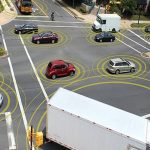Whatever the nature of the proposed highway system under consideration, be it a new motorway to link two cities or a network of highway improvements within an urban centre, and whatever planning strategy the decision-makers are adopting (assuming that the strategy involves, to some extent, the construction of new/upgraded roadways), a study must be carried out to determine the necessity or appropriateness of the proposal. This process will tend to be divided into two subsections:
· A transportation survey to establish trip-making patterns
· The production and use of mathematical models both to predict future transport requirements and to evaluate alternative highway proposals.
Transportation survey
Initially, the responsible transport planners decide on the physical boundary within which the study will take place. Most transport surveys have at their basis the land-use activities within the study area and involve making an inventory of the existing pattern of trip making, together with consideration of the socioeconomic factors that affect travel patterns. Travel patterns are determined by compiling a profile of the origin and destination (OD) of all journeys made within the study area, together with the mode of travel and the purpose of each journey. For those journeys originating within the study area, household surveys are used to obtain the OD information. These can be done with or without an interviewer assisting. In the case of the former, termed a personal interview survey, an interviewer records answers provided by the respondent. With the latter, termed a self-completion survey, the respondent completes a questionnaire without the assistance of an interviewer, with the usual format involving the questionnaire being delivered/mailed out to the respondent who then mails it back/has it collected when all questions have been answered.
For those trips originating outside the study area, traversing its external ‘cordon’ and ending within the study area, the OD information is obtained by interviewing trip makers as they pass through the ‘cordon’ at the boundary of the study area. These are termed intercept surveys where people are intercepted in the course of their journey and asked where their trip started and where it will finish.
A transportation survey should also gather information on the adequacy of existing infrastructure, the land use activities within the study area and details on the socio-economic classification of its inhabitants. Traffic volumes along the existing road network together with journey speeds, the percentage of heavy goods vehicles using it and estimates of vehicle occupancy rates are usually required. For each designated zone within the study area, office and factory floor areas and employment figures will indicate existing levels of industrial/ commercial activity, while census information and recommendations on housing densities will indicate population size. Some form of personal household-based survey will be required within each zone to determine household incomes and their effect on the frequency of trips made and the mode of travel used.
Production and use of mathematical models
At this point, having gathered all the necessary information, models are developed to translate the information on existing travel patterns and land-use profiles into a profile of future transport requirements for the study area. The four stages in constructing a transportation model are trip generation, trip distribution, modal split and traffic assignment. The first stage estimates the number of trips generated by each zone based on the nature and level of land-use activity within it. The second distributes these trips among all possible destinations, thus establishing a pattern of trip making between each of the zones. The mode of travel used by each trip maker to complete their journey is then determined and finally the actual route within the network taken by the trip maker in each case. Each of these four stages is described in detail in the next chapter. Together they form the process of transportation demand analysis which plays a central role within highway engineering. It attempts to describe and explain both existing and future travel behaviour in an attempt to predict demand for both car-based and other forms of transportation modes.



Comments are closed